Picture formats, photo paper and photo printing
I read an article about where the famous A4 format came from, and there in the comments the question arose of where the current photographic print formats came from.
To begin with, I’ll say what formats the readers of “Habr” and “Geeks” might have encountered at all.
-1 * 1 (79 * 79 mm) - such pictures were taken by Polaroid cameras of the 600th series.
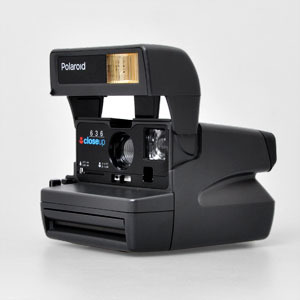
Almost everyone had or still have such a machine dusting on the mezzanines,

but the cassettes were not stored for a long time ...
-3 * 2 - such pictures are taken all cameras using 35 mm film
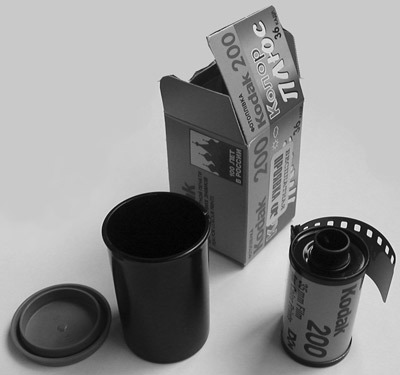
-4 * 3 - this format appeared with the advent of digital photography, so almost any digital soap box and smartphone take pictures with exactly this aspect ratio.

The 1 * 1 format turned out to be very convenient for the head to fit into it. Selfie lovers, this is not your first Instagram to decide to use a square frame.

The 3 * 2 format appeared not by chance and long before the appearance of the photograph as such. For many centuries, to build harmonious compositions, artists have used the concept of the so-called golden ratio.
The golden ratio is the division of the AC segment into two parts in such a way that most of its AB refers to the smaller BC, as the entire AC segment refers to AB (i.e. AB: BC = AC: AB). This ratio is approximately 5: 8.
First, build a square (highlighted in pink), then divide the base of the square in half (point X). We assume that the point X is the center of the circle, one of the points of which is the vertex of the square Y. Then we construct the circle until it intersects with the extension of the lower side of the square (point Z), and construct a rectangle through the point Z. As a result, we get a rectangle with an aspect ratio of 5: 8. The ratio of the values of line A to line C is the same as line B to line A. The 5: 8 ratio is very close to the aspect ratio of the standard frame (34:36 mm = 5: 7.5 = 2: 3).
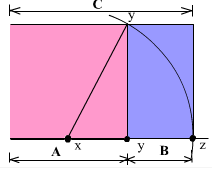
Having constructed such a rectangle, draw a line from the upper left corner to the lower right, and then the line towards the point Y (from the previous figure) until it intersects with the line dividing the rectangle into two parts.
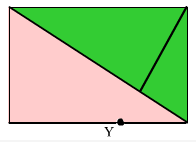
This rectangle can be rotated as you like, and if the frame is arranged so that three different objects are approximately located in these sectors, the composition will look harmonious.
Another example of using the golden ratio rule is the location of the main components of the frame at special points - visual centers. There are only four such points, and they are located at a distance of 3/8 and 5/8 from the corresponding edges of the plane. A person always focuses on these points, regardless of the frame format or picture.
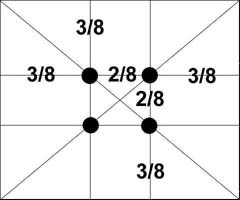
And here is how it looks in practice:
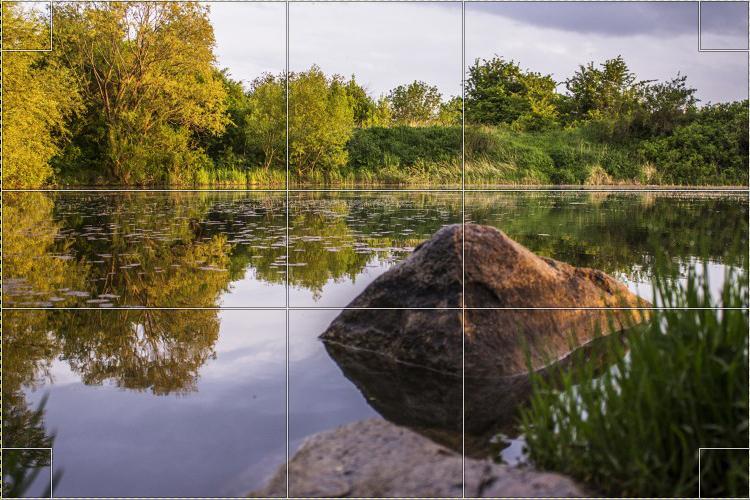

There is nothing interesting in the 4 * 3 format, it is simply adapted for viewing on a monitor, and here come the “classic” resolutions:
640 * 480 - this is how 0.3 megapixels
1280 * 960 mobile cameras shoot - about 1.3 MP
1600 * 1200 and 1632 * 1224 - 2 MP
2048 * 1536 - 3.2 MP, etc.
Digital SLR and system cameras in tribute to traditional film photos, with some exceptions, also use the 3 * 2 format. By the way, the “cropped” APS-C matrices (22.3 * 14.9 mm) also obey the laws of the golden ratio, since they are exactly 1.6 times smaller than the full frame 24 * 36 mm.
Standard sizes of photo paper come out of the classical film aspect ratio: 10 * 15 (it also roughly corresponds to 4 * 6 "), 13 * 18 (well, almost film, 1.5 mm from the long side" is eaten "), 20 * 30 (which is typical almost corresponds to A4), etc.
And now let's talk about the physical resolution of images and how they will look when printed.
Physical resolution is the resolution of an X image at Y points or, as camera manufacturers measure, the number of megapixels.
There is also a resolution measured in points per inch (PPI).
For example, the standard resolution of the monitor screen and prints intended for viewing from afar is 72 PPI, that is, at a distance of 1 inch, 72 points are placed in a row.
150 PPI - High enough resolution to make it possible to distinguish individual points.
300 PPI and more - photographic print quality.
Thus, in order to print a 10 * 15 image without loss in quality, you need an image of 2.1 megapixels:
10 / 2.54 * 300 = 1181
15 / 2.54 * 300 = 1772
1181 * 1772 = 2092732
Printers are not able to convey the color of one pixel by one dot. Instead, the printer uses a combination of very small dots of different colors (most often blue, crimson, yellow and black, sometimes light blue, light pink, light gray, green, etc.). Therefore, image resolutions in PPI and DPI (dots per inch) are completely different things.
There is a generally accepted rule: Resolution in PPI = resolution of the printer in DPI divided by the number of colors used (for the CMYK color model - 4).
Accordingly, if it is written on the printer that it prints with a resolution of 1200 DPI, then it will be able to print a picture in 300 PPI without loss of quality.
From here, the generally accepted matrix resolutions come out: for example, to print a pixel-to-pixel A4 image with a resolution of 300PPI, you need a camera with an 8-9 MP matrix (or 12, considering the cropping of the edges due to mismatch of aspect ratios) , for a magazine spread, 2 times more is required (18-24 MP), and for a wall calendar in A2 format - 36 MP.
To begin with, I’ll say what formats the readers of “Habr” and “Geeks” might have encountered at all.
-1 * 1 (79 * 79 mm) - such pictures were taken by Polaroid cameras of the 600th series.

Almost everyone had or still have such a machine dusting on the mezzanines,

but the cassettes were not stored for a long time ...
-3 * 2 - such pictures are taken all cameras using 35 mm film

-4 * 3 - this format appeared with the advent of digital photography, so almost any digital soap box and smartphone take pictures with exactly this aspect ratio.

The 1 * 1 format turned out to be very convenient for the head to fit into it. Selfie lovers, this is not your first Instagram to decide to use a square frame.

The 3 * 2 format appeared not by chance and long before the appearance of the photograph as such. For many centuries, to build harmonious compositions, artists have used the concept of the so-called golden ratio.
The golden ratio is the division of the AC segment into two parts in such a way that most of its AB refers to the smaller BC, as the entire AC segment refers to AB (i.e. AB: BC = AC: AB). This ratio is approximately 5: 8.
First, build a square (highlighted in pink), then divide the base of the square in half (point X). We assume that the point X is the center of the circle, one of the points of which is the vertex of the square Y. Then we construct the circle until it intersects with the extension of the lower side of the square (point Z), and construct a rectangle through the point Z. As a result, we get a rectangle with an aspect ratio of 5: 8. The ratio of the values of line A to line C is the same as line B to line A. The 5: 8 ratio is very close to the aspect ratio of the standard frame (34:36 mm = 5: 7.5 = 2: 3).
Having constructed such a rectangle, draw a line from the upper left corner to the lower right, and then the line towards the point Y (from the previous figure) until it intersects with the line dividing the rectangle into two parts.
This rectangle can be rotated as you like, and if the frame is arranged so that three different objects are approximately located in these sectors, the composition will look harmonious.
Another example of using the golden ratio rule is the location of the main components of the frame at special points - visual centers. There are only four such points, and they are located at a distance of 3/8 and 5/8 from the corresponding edges of the plane. A person always focuses on these points, regardless of the frame format or picture.

And here is how it looks in practice:
There is nothing interesting in the 4 * 3 format, it is simply adapted for viewing on a monitor, and here come the “classic” resolutions:
640 * 480 - this is how 0.3 megapixels
1280 * 960 mobile cameras shoot - about 1.3 MP
1600 * 1200 and 1632 * 1224 - 2 MP
2048 * 1536 - 3.2 MP, etc.
Digital SLR and system cameras in tribute to traditional film photos, with some exceptions, also use the 3 * 2 format. By the way, the “cropped” APS-C matrices (22.3 * 14.9 mm) also obey the laws of the golden ratio, since they are exactly 1.6 times smaller than the full frame 24 * 36 mm.
Standard sizes of photo paper come out of the classical film aspect ratio: 10 * 15 (it also roughly corresponds to 4 * 6 "), 13 * 18 (well, almost film, 1.5 mm from the long side" is eaten "), 20 * 30 (which is typical almost corresponds to A4), etc.
And now let's talk about the physical resolution of images and how they will look when printed.
Physical resolution is the resolution of an X image at Y points or, as camera manufacturers measure, the number of megapixels.
There is also a resolution measured in points per inch (PPI).
For example, the standard resolution of the monitor screen and prints intended for viewing from afar is 72 PPI, that is, at a distance of 1 inch, 72 points are placed in a row.
150 PPI - High enough resolution to make it possible to distinguish individual points.
300 PPI and more - photographic print quality.
Thus, in order to print a 10 * 15 image without loss in quality, you need an image of 2.1 megapixels:
10 / 2.54 * 300 = 1181
15 / 2.54 * 300 = 1772
1181 * 1772 = 2092732
Printers are not able to convey the color of one pixel by one dot. Instead, the printer uses a combination of very small dots of different colors (most often blue, crimson, yellow and black, sometimes light blue, light pink, light gray, green, etc.). Therefore, image resolutions in PPI and DPI (dots per inch) are completely different things.
There is a generally accepted rule: Resolution in PPI = resolution of the printer in DPI divided by the number of colors used (for the CMYK color model - 4).
Accordingly, if it is written on the printer that it prints with a resolution of 1200 DPI, then it will be able to print a picture in 300 PPI without loss of quality.
From here, the generally accepted matrix resolutions come out: for example, to print a pixel-to-pixel A4 image with a resolution of 300PPI, you need a camera with an 8-9 MP matrix (or 12, considering the cropping of the edges due to mismatch of aspect ratios) , for a magazine spread, 2 times more is required (18-24 MP), and for a wall calendar in A2 format - 36 MP.
